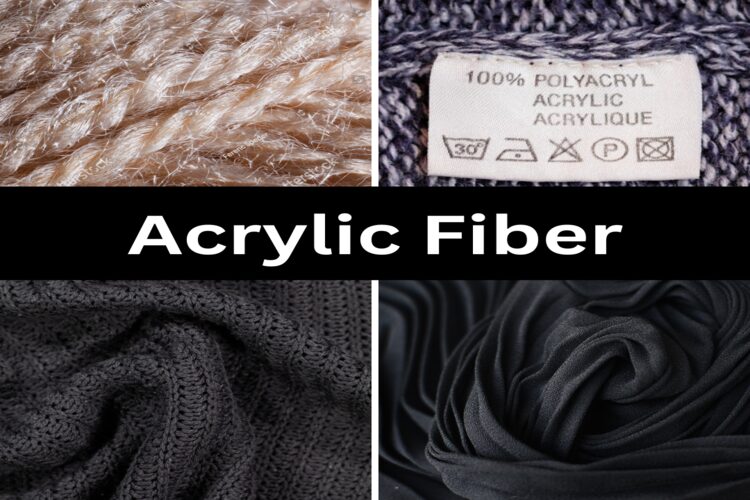What is Acrylic fiber?
Acrylic fiber is made from synthetic plastic. It comes from man-made polymer textile fibers created using chemicals from fossil fuels. Making acrylic fiber is similar to making polyamide, nylon fibers, and polyester fibers.
History And Origin of Acrylic
Acrylic was developed in Germany in 1893 to mimic wool. In 1950, the E.I. Dupont Company introduced it in the U.S. By 1991, it was popular for wash-and-wear items like sweaters and blankets. Acrylic fibers are made using wet and dry spinning methods, with the latter being more common. Care labels are important when handling acrylic, as it has unique characteristics. Acrylic is similar to wool fibers but has some differences. It gets crimped during dry spinning, providing warmth without extra weight. It’s a cost-effective alternative to wool, favored by consumers for its affordability and availability.
Types of Acrylic Fiber
In the market, you can find four main types of acrylic fabrics:
- Acrylic: Regular acrylic fiber, made of at least 85% pure acrylonitrile. Produced through wet or dry spinning methods. Texturized to give it a light, bulky, wool-like texture. Resistant to both acid and sunlight.
- Modacrylic: A variant of acrylic fiber, featuring a composition that includes acrylonitrile and a significant amount of vinylidene chloride. Offers a warm, pleasant feel with enhanced drivability, resiliency, and wrinkle resistance. Provides better resistance to pilling, flames, and abrasion compared to acrylic fabric. Excels in maintaining its shape, resisting wrinkles, and retaining creases. Often used in specialty applications. Common trade names for modacrylic fibers include Elura, SEF, Verel, and Zefran.
- Nytril: Unlike other acrylic variants relying on acrylonitrile, Nytril is primarily composed of vinylidene dinitrile. Produced from polymers containing at least 85% vinylidene dinitrile units and a vinyl acetate co-monomer. More popular in the Asian market than in the United States. It can be challenging to dye, and global production quantities are relatively small.
- Lastrile: Lastrile fibers are formed by blending copolymers of acrylonitrile and diene, such as butadiene. These fibers contain 10%-50% acrylonitrile units and are known for their elasticity. They are used in applications requiring greater elasticity in acrylic fibers. However, Lastrile fibers have not been widely produced for commercial use.
Properties of Acrylic Fiber
Acrylic fibers resist many chemicals, including acids, alkaline solutions, bleaches, and oxidizing agents.
- They can take sudden impacts without breaking because they have strong impact resistance.
- Acrylic fibers don’t easily absorb moisture due to their hydrophobic nature, but they can hold on to atmospheric moisture.
- They are durable, with excellent fatigue resistance that allows them to withstand repeated loads.
- Acrylic fibers can handle high temperatures from 160-250°C without melting.
- They don’t easily degrade or fade when exposed to sunlight, making them UV resistant.
- While they may slowly deform under constant load or stress due to low creep resistance.
- Acrylic fibers don’t dissolve in water or most organic solvents.
- They are flammable and can melt and drip when exposed to heat, but they self-extinguish when the heat source is removed.
- They also resist mildew and other microorganisms.
- Acrylic fibers are strong and can endure bending and twisting without breaking. They also have moderate to good abrasion resistance against wear and tear.
- By making chemical modifications, acrylic fibers can be customized to enhance specific properties or create different types of acrylic fibers.
Advantages of Acrylic Fiber
- It’s lightweight.
- It’s impressively durable.
- The fabric has exceptional elasticity, quickly returning to its original shape after stretching.
- It feels gentle to the touch.
- It keeps the wearer warm.
- It exhibits remarkable resistance to sunlight and weathering.
- It can be washed, depending on the fabric type and finish.
Disadvantages of Acrylic Fiber
- It can stretch and shrink easily.
- It has moderate strength.
- Because it repels moisture, it may cause static electricity and pilling.
- It degrades and changes color when exposed to extreme heat.
Use of Acrylic Fiber
- Apparel includes sweaters, socks, fleece clothing, circular-knit garments, sportswear, and children’s wear.
- Household textiles consist of carpets, blankets, area rugs, upholstery, and pile fabrics.
- Outdoor uses involve car tops, boat covers, awnings, and outdoor furniture.
- Industrial applications include filtration materials, construction reinforcement, and components for automotive batteries.
You may also like:
- What is Linen Fiber? Properties, Structure, and How It Made?
- What is Jute Fiber? Properties, Advantages and Disadvantages.
- What is Hemp Fiber? Properties, Advantages and Disadvantages.
- What is Ramie Fiber? Properties, Advantages and Disadvantages.
- What is Sisal Fiber? Properties, Structure, and How It Made?
- Pina Fiber: History, Properties, Production Process
- Coir Fiber: Properties, Production Process and Advantages
- Rayon Fiber: History, Properties, Advantages and Disadvantages
- Olefin Fiber: History, Properties, Advantages and Disadvantages
- Vinyon Fiber: History, Properties, Advantages and Disadvantages
Share this Article!

